Exploring the artists on our Giant Playbill
Following the unveiling of our Giant Playbill in September we went deeper into our archives to explore the amazing performers who feature on this special Hippodrome birthday artwork and their connections with the city.
Harry Houdini
Escapologist and illusionist, Harry Houdini, performed at the Hippodrome during three variety weeks, two in 1904 and one in 1908; firstly, demonstrating his handcuff act and then with his underwater escapology act. During his 1904 appearances, he borrowed a ‘straight waistcoat’ from the authorities of HM Prison Birmingham, Winson Green and constructed a model of a Birmingham police cell on the stage from which he escaped during every performance.
Gracie Fields
With nine appearances at the Hippodrome spanning 13 years (1925-1938), Gracie Fields was one of the most popular comediennes of her time. Billed as ‘England’s Greatest Comedienne’, she composed a number of songs including Sing As We Go, Mary Rose and Sally, which became her theme song. Her appearances at the Hippodrome in the late 1930’s broke box office records each year she appeared. In 1937, she had sold out all 15 performances of her variety week including three matinees, less than a week after they were put on sale. Four thousand tickets were sold in one booking.
Josephine Baker
Josephine Baker appeared at the Hippodrome during a variety week in December 1937, just a week after she had gotten married in Paris. She sent her costumes, scenery and her two dancing partners a week in advance of her visit but when she arrived in Birmingham, she was told that they had been held up by customs and wouldn’t be at the theatre in time for her first performance. She was forced to wear a white frock with blue shoes and she was unable to dance during her performance as her dress was not made for dancing.
Laurel & Hardy
Hollywood film stars, Stan Laurel and Oliver Hardy brought their slapstick style of comedy to Birmingham Hippodrome in 1947, 1952 and lastly in 1953. Their appearances were much anticipated by the Birmingham audiences but according to reports of their first time at the theatre, the anticipation was not lived up to in reality. Their allocated time slot was not long enough for the duo to display the sequence of events comedy style that people knew of from their films and although the standard of acting was up to the quality of their films, people left feeling a bit deflated.
Mae West
Mae West was a controversial playwright, singer, comedian and actress known for her double entendres and troubles with censorship. In December 1947, she made her one and only appearance on the Hippodrome stage in a play, which ran for a week, that she had written entitled Diamond Lil. The play was about an easy going, racy lady of the 1890s, with Mae playing the title role. The Birmingham reviews of her performance made more comments of her increased weight, stating that she was literally bringing more to her role in the UK than she did when she appeared on Broadway, rather than commenting on her acting or the theme of the play.
Danny Kaye
Danny Kaye’s week-long appearance in a variety show in June 1949 brought lots of excitement to the people of Birmingham. Due to unprecedented postal bookings, it was decided to open the box office on a Sunday, solely to take bookings for his performances. People started queueing the day before but were encouraged to go home and return the following day. When the queue reformed the following day, it wound around the streets of Birmingham from the Hippodrome and eventually made it to the Bullring. It was estimated that there were 10,000 people in the queue, although not all of those who had waited could be served. Half of the 24,000 tickets available were sold on that one day.
Julie Andrews
Julie Andrews’ first performance at Birmingham Hippodrome in April 1949, was at the age of 13, alongside her parents Ted and Barbara Andrews. She was described as having a mature voice for her age. When she returned in her own right in the variety show Look In, a review from the Birmingham Daily Gazette stated “she goes to the hearts of the audience by the shortest and quickest route.”
Judy Garland
In July 1951, a Hollywood legend made her appearance on the Hippodrome stage. The film star, Judy Garland, appeared on a variety bill that also saw the appearance of another act featured on our giant playbill: Professor Duncan’s Collies! Her performance was tumultuously applauded by the audiences who flocked to see her every performance. She appeared nervous on stage, giggling with the audience and mopping her brow but her performance was reported as a “technical triumph”. During the week she performed at the Hippodrome, Judy, who had not seen her five-year-old daughter in three months, was reunited with Liza.
Ken Dodd
From 1957 to 2010, Ken Dodd made a total of 17 appearances at Birmingham Hippodrome in various shows including pantomime, variety and his own Laughter and Happiness solo comedy performances. His first appearance at the Hippodrome began on April Fool’s Day 1957 and was described as “the performer-audience contact is kept alive, and this is what makes such a profound impression”. His affection by the Birmingham audiences meant he was invited by the theatre to lay the foundation stone for the 1999 major redevelopment work, which saw the complete knocking down and modernisation of the foyer spaces and backstage areas.
Sammy Davis Jnr
When impresario Bernard Delfont presented Sammy Davis Jr. Swings and Sings at the Hippodrome for two performances in 1961, it was because Sammy owed Bernard a favour. During his stint at the Prince of Wales Theatre in London, Sammy asked Bernard if he could take time off to honour the Jewish holy day of Yom Kippur. Bernard, also Jewish, agreed, which meant that two London shows had to be cancelled at the last minute and at great cost. To compensate, Sammy offered to perform two shows in Birmingham for free.
The Beatles
1963 saw two visits to Birmingham Hippodrome by the iconic group. For their first appearance in March they were at the bottom of the bill, and then they were headliners by their second performance in November. Birmingham City Police had to put together a plan to solve the issue of crowd control during the group’s November visit, stating that most of the issues are not caused by ticketholders but by onlookers. The police plan involved the group driving to HQ in Steelhouse Lane, dressing them up in mackintoshes and police helmets and then driving them, along with seven policemen, in a Black Maria to the theatre. Decoy police cars preceded their arrival allowing the black van to slip through the crowd and into a small gated yard by stage door. The two Sunday performances sold out within two days and extra theatre staff had to be laid on to deal with gate crashers.
Marlene Dietrich
As part of a six week solo tour of England, Marlene Dietrich made a week’s visit at the Hippodrome in August 1965. Her limited vocal range and husky voice were enhanced by the accompaniment of an 18-piece orchestra and by the musical arrangements by Burt Bacharach. Marlene made a special visit on Tuesday 10 August to meet the Lord Mayor of Birmingham who had been a fan of hers since he first saw her on the big screen. He described her as “a distinguished visitor to the city” and was “looking forward with tremendous interest to meeting her”.
Professor Duncan’s Collies
Professor Duncan’s Collies was an act which appeared at the Hippodrome 18 times over a 55-year span (1900 – 1955), appearing on variety bills alongside big names such as Harry Houdini and Judy Garland. The act included the collies skipping, somersaulting, leapfrogging and dancing to bagpipes played by their trainers. Their finale involved the dogs acting out a tragic scene either involving a car crash or a rescue from a burning building. In both scenes, at least one dog would ‘die’ from either their injuries or due to shock, and their grief-stricken widow would fall to her knees at his side.
Miss Moto
The act of ‘Hooping the Hoop’ was performed on the Tivoli Stage in July 1903 by Miss Moto. It involved a 60ft inclined track leading to a hoop 63ft in circumference. The motorcar was released at the top of the incline through a trap door and after completing the manoeuvre the car was caught in a net at the end of the track. During the first house on the Tuesday night, the car hit a guide rail, causing it to lose momentum and crash through the hoop. Miss Moto miraculously survived with only a few abrasions, but the car and hoop were severely damaged. Audiences flooded to the Tivoli during the rest of the week to see if she would make it round each performance.
Claire Heliot
In February 1904, for two weeks (as it was held over for a second week), 12 lions and 2 boarhounds performed on the Hippodrome stage in a 12ft high cage with ‘absolutely no danger to the audience’. Claire Heliot, a lion tamer from Germany, took her lions through a routine which included them lying on the ground for her to recline upon, the dogs leaping over a number of the lions and the lions performing a circus routine. One scene involved the lions sitting on stools at a table whilst Claire fed them raw meat. The finale involved Claire carrying a 159Kg lion across her shoulders and out of the ring.
The First Original Great Kettle Act
Billed as ‘t he greatest performance ever witnessed on any stage’, The First Original Great Kettle Act had a lot to live up to when it was seen here in November 1904. The American demonstrator, Ralph Dean, used liquid air, which he made himself, to show a number of feats. He made rubber balls so brittle they would shatter to pieces, turned grapes into hail stones in a matter of seconds, poured ‘boiling water’ onto eggs freezing them into a block of ice so they could be broken by a hammer and reduced a test tube of kerosene to ice, which he then set alight.
Dr. Walford Bodie
Between 1905 and 1918, Dr. Walford Bodie ‘The Bloodless Surgeon’ performed his act five times on the Hippodrome stage. Predominantly featuring the power of (static) electricity his act involved using it to hypnotise young men in the audience making them sing, dance and give speeches and more controversially using the electricity to ‘cure’ people of their paralysis. The show’s review from March 1906, described Bodie as a ‘modern miracle worker’ who would offer any person a £1,000 to prove that his cures were not genuine.
Electra
Electra is a mysterious act, which appeared on a variety show in October 1907 on a bill that also featured comedians, a magician, gymnasts and a dog act. Electra was billed as ‘the dance of 10,000 lights – absolutely the prettiest show ever put on the stage – must be seen to be appreciated’. A review of the show stated that the dancer wore dresses of “ever-changing colours and the display of lights makes one of the most artistic and beautiful shows ever seen on these boards”.
Princess Trixie
The ‘Queen of All Educated Horses’, Princess Trixie appeared at the Hippodrome in two variety weeks during 1908. She was a light grey mare, born and trained in America by her master Mr. W. H. Barnes. She was able to perform a multitude of tasks including basic arithmetic, selecting coloured handkerchiefs to match colours called out by the audience, spelling words using wooden blocks with painted letters and using a cash register to give change of up to 2 American Dollars. She even wrote her own autobiography, where she gives an account of her training, performances and her life with her master.
The Great Carmo
During eight appearances at the Hippodrome from 1911 to 1932, The Great Carmo brought his circus complete with a menagerie of exotic animals to Birmingham Hippodrome. The magician made a wealth of animals and inanimate objects vanish and reappear at will, including a caged lion. In March 1930, Birmingham proved to be particularly unlucky for Carmo. He pitched his travelling circus tent in Digbeth but a heavy snowfall ended breaking the wooden poles holding up the canvas, collapsing the entire marquee. After paying out for a new tent to enable the performances to continue the unlucky streak continued when less than a week later the tent caught fire and burned down.
Fred Barnes
Birmingham-born light comedian Fred Barnes was a popular star of British music halls in the early 1900s and he made a total of five appearances at the Hippodrome between 1912 and 1932. He was known as the ‘Adonis of the Halls’, due to his blue eyes, wavy hair and tendency to dress as a debonair man-about-town. Fred was openly gay and he wrote a song entitled ‘The Black Sheep of the Family’, which became his theme song. Two weeks before his 1913 performance at the Hippodrome, his father committed suicide due to shame and Fred wrote in his autobiography that the Hippodrome was “a place full of memories of my father. To this day, I don’t know how I got through that week.”
George Ross
Billed as ‘The Topsy-Turvy Pianist’ and the ‘One-Man Music Hall’, George Ross appeared at the Hippodrome as part of a variety show in May 1913 along with Dorothy Ward and Shaun Glenville. His performance as a pianist was taken to the next level by the positions in which he played it, one of which was whilst standing on his head, earning him his nickname. One review stated that George “shows there are more ways of playing a piano than one – that is for the acrobatically inclined.”
Du’Calion
In July 1913 and again in May 1914, ‘the loquacious laddie on the tottering ladder’ performed on the Hippodrome stage. Du’Calion, who was also known as ‘The Priceless Piffler on His Perilous Perch’, perfected a balancing act, which saw him balance on top of a gently swaying ladder, where he chatted to the audience, sang and even played the mandolin. He would tell the audiences closest to the stage that it was “much safer up here!”. Among his song repertoire was the nonsensical song of ‘We’re Feeding the Baby Garlic, So We Can Find Him in The Dark!’.
Gert & Daisy
Played by Doris and Elsie Waters, the characters of Gert and Daisy were popular with Hippodrome patrons, making a total of 15 appearances between 1933 and 1955. The characters would talk about anything and everything including tales about their fictional husbands Bert and Wally. Reviews described the turn as “the outstanding performance of the evening” and “among the comparatively few real stage comics of our time, who cheer you up by the warmth of human kindness in them… They are, as the phrase goes, a tonic.”
The Giant Playbill can be seen in our main foyer next to our Coffee Bar.
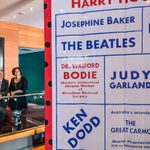

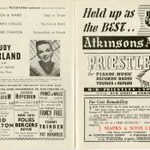
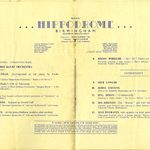
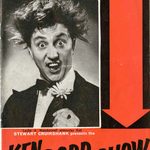
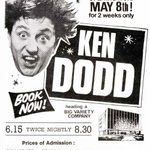

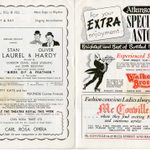

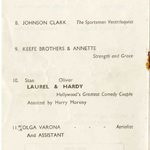
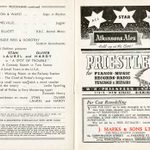
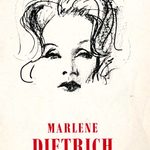
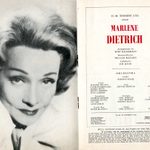
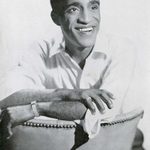
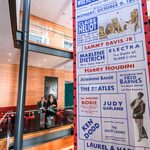
Comments
Leave Comment